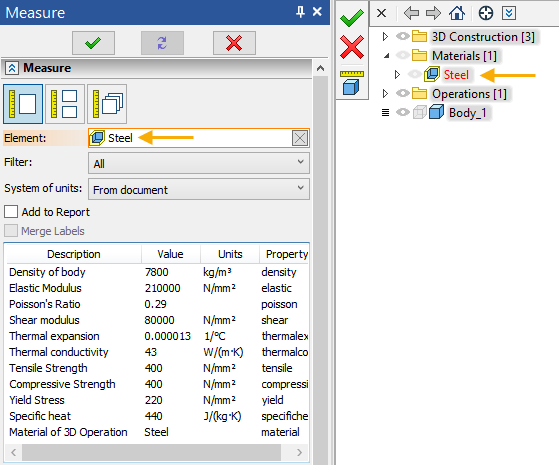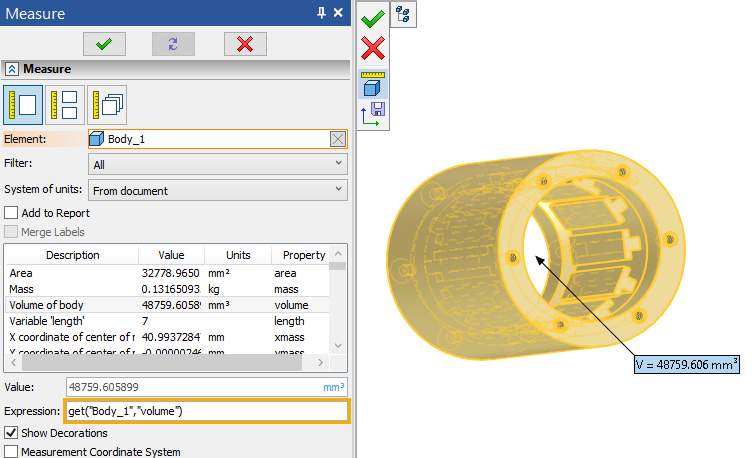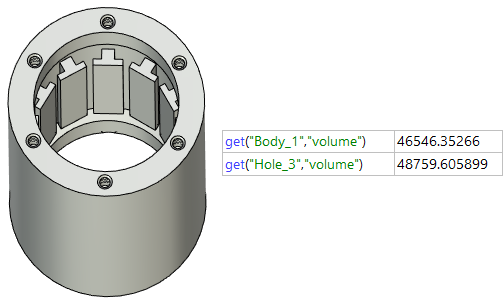Measure Parameters of Single Element |
  
|
The mode of measuring parameters of a single element can be activated using the following button located in the upper section of the ![]() Measure command's parameters window:
Measure command's parameters window:
|
<1> |
Measure one element parameter |
After enabling this mode, the Element box gets automatically activated in the command's parameters window. As long as this box is active, clicking an element of almost any type with ![]() in 2D window, 3D window or 3D model tree selects such element as the object of measurement. If the object is already selected, clicking another element replaces the selection. Name and icon of the selected element are displayed in the Element box. The selection can be cleared using the
in 2D window, 3D window or 3D model tree selects such element as the object of measurement. If the object is already selected, clicking another element replaces the selection. Name and icon of the selected element are displayed in the Element box. The selection can be cleared using the ![]() Clear button located at the right side of the box.
Clear button located at the right side of the box.
If no more than a single element is selected at the moment of calling the command, then the command gets launched in this mode.
If a single element is selected at the moment of entering this mode, then such element is automatically used as the object of measurement.
If multiple elements are selected at the moment of entering this mode, then the first selected element is automatically used as the object of measurement and the rest of the elements get unselected.
The set of parameters to be measured depends on the type of selected object.
The simplified version of this mode, which measures only the mass-inertia properties of 3D modeling operations, is available as the separate Mass Properties command.
Measurement of material properties
The ![]() Measure command in the
Measure command in the ![]() Measure one element parameter mode allows selecting a material in the 3D model tree for measuring its physical properties.
Measure one element parameter mode allows selecting a material in the 3D model tree for measuring its physical properties.

Measured values of physical properties of materials can be written into variables for use in calculations, which eliminates the need to enter them manually.
The automenu of the ![]() Measure command in the
Measure command in the ![]() Measure one element parameter mode contains the following option:
Measure one element parameter mode contains the following option:
|
<B> |
Body measurement mode |
The body measurement mode allows you to create a measurement expression in which the measured object is a body. This is how it differs from measurement in the default mode with selecting bodies using an element type filter.
![]()
Upon selecting a body using a filter in the default mode, not the body itself will be written to the measurement expression, but the last operation of this body in the model tree. The example below illustrates the difference in measurement expression caused by different methods of selecting the same body:

|
|
Body measurement mode |
Selecting body using filter |
Both methods may be heplful. For example, if you create a variable based on the expression obtained in the mode of measuring bodies, then with further changes in the model tree of the selected body, the value of the variable will be recalculated accordingly: by adding a hole to the body, we will change the volume of the body and this will be taken into account in the variable. On the other hand, if we need to know the volume of a certain body without taking into account further changes in its model tree, then we need to make a measurement in the default mode with selecting the body using a filter: in this case, the measurement will be made only before the operation, which at the time of measurement was the last, and all subsequent changes to the body model tree will not be taken into account.

See Also:
•Measurement Coordinate System
•Labels of Measurement Results
•Save Measurement Results in 3D Model Tree
•3D Node by Measurement Results